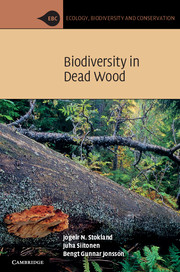Book contents
- Frontmatter
- Contents
- Preface
- 1 Introduction
- 2 Wood decomposition
- 3 The saproxylic food web
- 4 Other associations with dead woody material
- 5 Host-tree associations
- 6 Mortality factors and decay succession
- 7 Microhabitats
- 8 Tree size
- 9 The surrounding environment
- 10 Evolution of saproxylic organisms
- 11 Species diversity of saproxylic organisms
- 12 Natural forest dynamics
- 13 Dead wood and sustainable forest management
- 14 Population dynamics and evolutionary strategies
- 15 Threatened saproxylic species
- 16 Dead wood in agricultural and urban habitats
- 17 The value and future of saproxylic diversity
- References
- Index
2 - Wood decomposition
Published online by Cambridge University Press: 05 June 2012
- Frontmatter
- Contents
- Preface
- 1 Introduction
- 2 Wood decomposition
- 3 The saproxylic food web
- 4 Other associations with dead woody material
- 5 Host-tree associations
- 6 Mortality factors and decay succession
- 7 Microhabitats
- 8 Tree size
- 9 The surrounding environment
- 10 Evolution of saproxylic organisms
- 11 Species diversity of saproxylic organisms
- 12 Natural forest dynamics
- 13 Dead wood and sustainable forest management
- 14 Population dynamics and evolutionary strategies
- 15 Threatened saproxylic species
- 16 Dead wood in agricultural and urban habitats
- 17 The value and future of saproxylic diversity
- References
- Index
Summary
When you sit beside a campfire you can easily feel the energy that is tied up in woody material. As the wood burns, it is transformed to carbon dioxide, water vapour and minerals – the elements that the tree tied up through photosynthesis when it was alive and growing. The combustion of wood in the campfire takes only a few hours. In temperate and boreal forest ecosystems the equivalent degradation of a tree typically takes 50–100 years and is carried out by numerous wood decomposers working at a much lower temperature.
This chapter deals with the activity of these decomposers – how they degrade and recycle dead wood in forest ecosystems all over the globe. Fungi are the principal decomposers in terrestrial ecosystems, and especially among the basidiomycetes we find many effective wood-decaying species. Also a large number of invertebrates, such as beetles and termites, take part in the process of wood decomposition. Before we explore this fundamental ecosystem process, we shall describe some key aspects of wood structure.
Structural wood components
Wood is made up of three structural components: cellulose, hemicellulose and lignin. The chemical composition, synthesis and degradation of these economically important wood constituents have been important research topics for more than 50 years – and they still are. As a result, we have a good understanding of their biochemical properties. It is beyond the scope of this book to go into great detail about these specialized topics, which are regularly reviewed in books and scientific journals (see Buswell, 1991 ; Markham and Bazin, 1991 ; Jeffries, 1994 ; Schwarze et al., 2000b ; Vicuña, 2000 ; Martínez et al., 2005 ; Baldrian, 2008 ).
- Type
- Chapter
- Information
- Biodiversity in Dead Wood , pp. 10 - 28Publisher: Cambridge University PressPrint publication year: 2012
- 12
- Cited by



